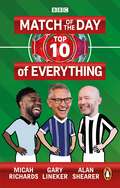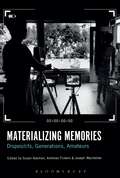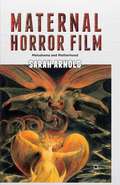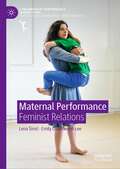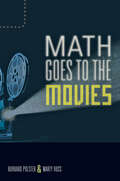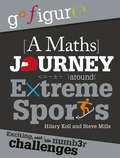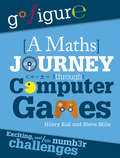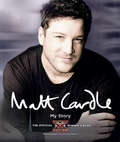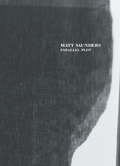- Table View
- List View
Masters of FX: Behind the Scenes with Geniuses of Visual and Special Effects
by Ian FailesIt would be rare these days to find a film that did not in some way depend on the magic of visual effects, from the raging computer-generated dinosaurs in Steven Spielberg's Jurassic Park, to the fantastical worlds of Tim Burton's Alice in Wonderland, and the photoreal tiger and ocean in Ang Lee's Life of Pi. Through interviews with 16 of the leading effects pioneers from around the world (see list below), author Ian Failes explores the making of some of the most memorable film sequences ever produced, showcasing the shift from practical to digital magic with original behind-the-scenes imagery, shot breakdowns, and detailed explanations of some of the secrets behind the making of cinema's most extraordinary creations. Visual effects artists and films discussed include: Dennis Muren (Star Wars: Episodes IV–VI; Terminator 2: Judgment Day; Jurassic Park; A.I. Artificial Intelligence; War of the Worlds) Bill Westenhofer (Babe: Pig in the City; Cats & Dogs; The Lion, the Witch and the Wardrobe; The Golden Compass; Life of Pi) Joe Letteri (The Lord of the Rings trilogy; King Kong; Avatar; Planet of the Apes; The Hobbit trilogy) Rob Legato (Apollo 13; Titanic; The Aviator; Hugo) Paul Franklin (Pitch Black; Christopher Nolan’s The Dark Knight trilogy; Inception; Interstellar) Richard Edlund (Star Wars: Episodes IV–VI; Raiders of the Lost Ark; Ghostbusters; Multiplicity); Edson Williams (X-Men: The Last Stand; The Curious Case of Benjamin Button; The Social Network; Captain America films) Karen Goulekas (Godzilla; The Day After Tomorrow; 10,000 BC; Green Lantern); Chris Corbould (Golden Eye; Die Another Day; Christopher Nolan’s The Dark Knight trilogy; Inception); Ian Hunter (The X-Files; The Dark Knight; The Dark Knight Rises; Inception; Interstellar) John Rosengrant (Terminator films; Jurassic Park; Iron Man films; Real Steel)
Masters of FX: Behind the Scenes with Geniuses of Visual and Special Effects
by Ian FailesIt would be rare these days to find a film that did not in some way depend on the magic of visual effects, from the raging computer-generated dinosaurs in Steven Spielberg's Jurassic Park, to the fantastical worlds of Tim Burton's Alice in Wonderland, and the photoreal tiger and ocean in Ang Lee's Life of Pi. Through interviews with 16 of the leading effects pioneers from around the world (see list below), author Ian Failes explores the making of some of the most memorable film sequences ever produced, showcasing the shift from practical to digital magic with original behind-the-scenes imagery, shot breakdowns, and detailed explanations of some of the secrets behind the making of cinema's most extraordinary creations. Visual effects artists and films discussed include: Dennis Muren (Star Wars: Episodes IV–VI; Terminator 2: Judgment Day; Jurassic Park; A.I. Artificial Intelligence; War of the Worlds) Bill Westenhofer (Babe: Pig in the City; Cats & Dogs; The Lion, the Witch and the Wardrobe; The Golden Compass; Life of Pi) Joe Letteri (The Lord of the Rings trilogy; King Kong; Avatar; Planet of the Apes; The Hobbit trilogy) Rob Legato (Apollo 13; Titanic; The Aviator; Hugo) Paul Franklin (Pitch Black; Christopher Nolan’s The Dark Knight trilogy; Inception; Interstellar) Richard Edlund (Star Wars: Episodes IV–VI; Raiders of the Lost Ark; Ghostbusters; Multiplicity); Edson Williams (X-Men: The Last Stand; The Curious Case of Benjamin Button; The Social Network; Captain America films) Karen Goulekas (Godzilla; The Day After Tomorrow; 10,000 BC; Green Lantern); Chris Corbould (Golden Eye; Die Another Day; Christopher Nolan’s The Dark Knight trilogy; Inception); Ian Hunter (The X-Files; The Dark Knight; The Dark Knight Rises; Inception; Interstellar) John Rosengrant (Terminator films; Jurassic Park; Iron Man films; Real Steel)
Masters of Make-Up Effects: A Century of Practical Magic
by Howard Berger Marshall JuliusDive into the fascinating world of movie make-up effects with this stunning illustrated oral history of the art form. Masters of Make-Up Effects is a celebration of make-up artists and acclaimed make-up effects from the world of film and television. Authors Howard Berger and Marshall Julius have gleaned untold stories from the sets of cult classics (Planet of the Apes, An American Werewolf in London, The Thing), fan-favourite film and TV franchises (Star Trek, Star Wars, Harry Potter and the MCU) and modern blockbusters like Dune to chart the fascinating evolution of an industry.Lavishly illustrated with hundreds of behind-the-scenes photos, many of which have never before been seen in print or on social media, it showcases some of the most iconic make-up effects of all time, while revealing how they came to be in the artists' own words.Featuring a foreword by Guillermo del Toro, an afterword by Seth MacFarlane, and contributions from more than 50 make-up effects legends, as well as iconic actors including Doug Jones, Robert Englund, James McAvoy and Doug Bradley, and directors Mick Garris and John Landis, Masters of Make-Up Effects is the most complete book on movie make-up history ever assembled, and a must read for cinema fans everywhere.
The Masters of Sitcom: From Hancock to Steptoe
by Christopher StevensRay Galton and Alan Simpson are two of the most influential and celebrated television scriptwriters of our time. Praised for inventing the sitcom, their own seminal creations are still standing the test of time with modern audiences - Hancock's Half Hour and Steptoe and Son are two of the most successful sitcoms ever made. This book is a charming tribute to their career in comedy, written in collaboration with Galton and Simpson themselves and with exclusive access to their personal archive of scripts. Readers will discover the fascinating story of their progress from variety shows to television, and how they came to create characters and programmes that have captured the nation's heart for generations. Their insightful comments on their own writing, along with their first-class understanding of the television writers' craft, make this anthology unique, informative and incredibly entertaining.
Match of the Day: Our Ultimate Football Debates
by Gary Lineker Alan Shearer Micah RichardsFootball isn't life or death - it's much more serious than that...Which players will the fans never forget? Who are the Premier League's best buys? Who were the best link ups in history? Who is the biggest tough guy, Vinnie Jones or Stuart Pearce?In Match of the Day Top 10 of Everything, Gary Lineker, Alan Shearer and Micah Richards bring all of the charm, wit and punditry of their hit BBC Sounds podcast onto the page, arguing the toss over their favourite strikers, Premier League managers, shock transfers, cult heroes, hard men, FA Cup Finals, and much, much more. This brilliant collection goes deeper into some of the topics from the podcast and offers a huge dose of new lists exclusive to the book. It's the ultimate gift for the football fan on your list. The question is...will you agree with their picks?
Matchbox Theatre: Thirty Short Entertainments
by Michael FraynMatchbox Theatre presents a miniature sketch show: thirty dialogues and monologues by Michael Frayn, to be played in the smallest theatre in the world - the theatre of your own imagination.Sir Geoffrye and Lady Hilarye, sleeping peacefully on their marble tomb these last six hundred years, are woken by the thump of rock music in the crypt beneath them...A gala performance of Shakespeare, and as a special treat the sponsor's guests are being wined and dined on stage as extras in the banquet scene...The eternal triangle in an airport departure lounge: two lovers and the flight announcements...The scripts are provided. Everything else - casting, set design, ice-cream sales - is up to the reader...
Materialities in Dance and Performance: Writing, Documenting, Archiving (TanzScripte #70)
by Gabriele Klein Franz Anton CramerWhat is »materiality« in dance and performance? What role does »the material« play in the formation for the cultural memory of ephemeral arts? The contributors to this volume examine concepts of materiality in dance and performance, the use of materials in artistic practices and the role of social media in changing the perception of time-based artefacts. The volume shows how the focus on materiality transforms contemporary artistic work and challenges established concepts of dance and performance research.
Materiality of Cooperation (Medien der Kooperation – Media of Cooperation)
by Sebastian Gießmann Tobias Röhl Ronja Trischler Martin ZillingerThe volume investigates the socio-material dimension and media practices of cooperation – before, during and beyond situations. Cooperation is understood as reciprocal interplay operating with or without consensus, in co-presence or absence of the involved actors in distributed situations. Artefacts, bodies, texts and infrastructures are the media that make cooperation possible. They enable and configure reciprocal accomplishments – and are themselves created through media practices in cooperative situations.
Materializing Memories: Dispositifs, Generations, Amateurs
by Andreas Fickers Susan Aasman Joseph WachelderA multitude of devices and technological tools now exist to make, share, and store memories and moments with family, friends, and even strangers. Memory practices such as home movies, which originated as the privilege of a few, well-to-do families, have now emerged as ubiquitous and immediate cultures of sharing. Departing from the history of home movies, this volume offers a sophisticated understanding of technologically mediated, mostly ritualized memory practices, from early beginnings in the fin-de-siècle to today.Departing from a longue durée perspective on home movie practices, Materializing Memories moves beyond a strict historical study to grapple with highly theorized fields, such as media studies, memory studies, and science and technology studies (STS). The contributors to this volume reflect on these different intellectual backgrounds and perspectives, but all chapters share a common framework by addressing practices of use, user configurations, and relevant media landscapes. Grasping the cultural dynamics of such multi-faceted practices requires a multidimensional conceptual approach, here achieved by centering around three concepts as central analytical lenses: dispositifs, generations, and amateurs.
Materializing Memories: Dispositifs, Generations, Amateurs
by Andreas Fickers Susan Aasman Joseph WachelderA multitude of devices and technological tools now exist to make, share, and store memories and moments with family, friends, and even strangers. Memory practices such as home movies, which originated as the privilege of a few, well-to-do families, have now emerged as ubiquitous and immediate cultures of sharing. Departing from the history of home movies, this volume offers a sophisticated understanding of technologically mediated, mostly ritualized memory practices, from early beginnings in the fin-de-siècle to today.Departing from a longue durée perspective on home movie practices, Materializing Memories moves beyond a strict historical study to grapple with highly theorized fields, such as media studies, memory studies, and science and technology studies (STS). The contributors to this volume reflect on these different intellectual backgrounds and perspectives, but all chapters share a common framework by addressing practices of use, user configurations, and relevant media landscapes. Grasping the cultural dynamics of such multi-faceted practices requires a multidimensional conceptual approach, here achieved by centering around three concepts as central analytical lenses: dispositifs, generations, and amateurs.
Materials for Learning: How to Teach Adults at a Distance (Routledge Library Editions: Broadcasting #26)
by Janet JenkinsMaterials for Learning (1981) examines the ability of books and broadcasts to change lives. The combination of print, radio, television and group meetings – distance teaching – can transform education in developing countries. Effective distance teaching requires effective teaching materials, and up to now there has been a lack of guidance about how to produce such materials and how to do so for different cultures. Materials for Learning aims to supply this need by suggesting guidelines for action and, where evidence is mixed or lacking, defining questions that still require answers. It is a practical book aimed at people actively involved in nonformal education and will be particularly useful for the developing world educators. The book looks first at how distance teaching can help with educational problems, considers how adults learn, and surveys problems of language and culture. It then considers the planning of distance teaching and looks in detail at the use of different media. There were also chapters on teaching numeracy and science at a distance, and a discussion of the kind of support that can be provided for people studying at a distance.
Materials for Learning: How to Teach Adults at a Distance (Routledge Library Editions: Broadcasting #26)
by Janet JenkinsMaterials for Learning (1981) examines the ability of books and broadcasts to change lives. The combination of print, radio, television and group meetings – distance teaching – can transform education in developing countries. Effective distance teaching requires effective teaching materials, and up to now there has been a lack of guidance about how to produce such materials and how to do so for different cultures. Materials for Learning aims to supply this need by suggesting guidelines for action and, where evidence is mixed or lacking, defining questions that still require answers. It is a practical book aimed at people actively involved in nonformal education and will be particularly useful for the developing world educators. The book looks first at how distance teaching can help with educational problems, considers how adults learn, and surveys problems of language and culture. It then considers the planning of distance teaching and looks in detail at the use of different media. There were also chapters on teaching numeracy and science at a distance, and a discussion of the kind of support that can be provided for people studying at a distance.
Maternal Horror Film: Melodrama and Motherhood
by S. ArnoldMaternal Horror Film: Melodrama and Motherhood examines the function of the mother figure in horror film. Using psychoanalytic film theory as well as comparisons with the melodrama film, Arnold investigates the polarized images of monstrous and sacrificing mother.
The Maternal Imagination of Film and Film Theory
by Lauren BlissThis book challenges common sense understandings of the unconscious effects of cinema and visual culture. It explores the castrating power of the early modern witch and the historical belief that pregnant women could manipulate and distort body image as figurative analogies for feminist theories of objectification and the male gaze. Through developing this history as an impure but lively analogy, this book serves as a provocation against the dominant imagining of objectification. It offers innovative analyses of a wide-ranging selection of films and topics including Joyce Wieland’s Water Sark (1964) and its resonance with the works of John Cage and Stan Brakhage; the documentary Histoires d’A (History of Abortion, 1973), which contributed to the successful legalisation of abortion in France; the Hong Kong horror film Dumplings (Jiaozi, 餃子 2004), where foetal cannibalism serves up an image of censorship; and the dual productions The Book of Mary (Le livre de Marie) and Hail Mary (Je vous salue, Marie, 1985) by Anne-Marie Miéville and Jean-Luc Godard that figure a self-reproducing virgin who hears herself while remaining a virgin, unseen.
Maternal Performance: Feminist Relations (Contemporary Performance InterActions)
by Lena Šimić Emily Underwood-LeeMaternal Performance: Feminist Relations bridges the fields of performance, feminism, maternal studies, and ethics. It loosely follows the life course with chapters on maternal loss, pregnancy, birth, aftermath, maintenance, generations, and futures. Performance and the maternal have an affinity as both are lived through the body of the mother/artist, are played out in real time, and are concerned with creating ethical relationships with an other – be that other the child, the theatrical audience, or our wider communities. The authors contend that maternal performance takes the largely hidden, private and domestic work of mothering and makes it worthy of consideration and contemplation within the public sphere.
Math Goes to the Movies
by Burkard Polster Marty RossMel Gibson teaching Euclidean geometry, Meg Ryan and Tim Robbins acting out Zeno's paradox, Michael Jackson proving in three different ways that 7 x 13 = 28. These are just a few of the intriguing mathematical snippets that occur in hundreds of movies. Burkard Polster and Marty Ross pored through the cinematic calculus to create this thorough and entertaining survey of the quirky, fun, and beautiful mathematics to be found on the big screen. Math Goes to the Movies is based on the authors' own collection of more than 700 mathematical movies and their many years using movie clips to inject moments of fun into their courses. With more than 200 illustrations, many of them screenshots from the movies themselves, this book provides an inviting way to explore math, featuring such movies as:• Good Will Hunting• A Beautiful Mind• Stand and Deliver• Pi• Die Hard• The Mirror Has Two FacesThe authors use these iconic movies to introduce and explain important and famous mathematical ideas: higher dimensions, the golden ratio, infinity, and much more. Not all math in movies makes sense, however, and Polster and Ross talk about Hollywood's most absurd blunders and outrageous mathematical scenes. Interviews with mathematical consultants to movies round out this engaging journey into the realm of cinematic mathematics.This fascinating behind-the-scenes look at movie math shows how fun and illuminating equations can be.
Math Goes to the Movies
by Burkard Polster Marty RossMel Gibson teaching Euclidean geometry, Meg Ryan and Tim Robbins acting out Zeno's paradox, Michael Jackson proving in three different ways that 7 x 13 = 28. These are just a few of the intriguing mathematical snippets that occur in hundreds of movies. Burkard Polster and Marty Ross pored through the cinematic calculus to create this thorough and entertaining survey of the quirky, fun, and beautiful mathematics to be found on the big screen. Math Goes to the Movies is based on the authors' own collection of more than 700 mathematical movies and their many years using movie clips to inject moments of fun into their courses. With more than 200 illustrations, many of them screenshots from the movies themselves, this book provides an inviting way to explore math, featuring such movies as:• Good Will Hunting• A Beautiful Mind• Stand and Deliver• Pi• Die Hard• The Mirror Has Two FacesThe authors use these iconic movies to introduce and explain important and famous mathematical ideas: higher dimensions, the golden ratio, infinity, and much more. Not all math in movies makes sense, however, and Polster and Ross talk about Hollywood's most absurd blunders and outrageous mathematical scenes. Interviews with mathematical consultants to movies round out this engaging journey into the realm of cinematic mathematics.This fascinating behind-the-scenes look at movie math shows how fun and illuminating equations can be.
Mathieu Kassovitz (French Film Directors Series)
by Will HigbeeMathieu Kassovitz is arguably the most important filmmaker to have emerged from French cinema in the past two decades. As a director, his work often engages with highly controversial socio-political issues whilst still managing to attract and connect with a popular audience – and, above all, with a youth audience. He is also one of the few contemporary French filmmakers who is capable of productively engaging with Hollywood, in terms of cinematic style, narrative and genre, yet still retaining his own identity as a French filmmaker. In addition to his directorial successes, Kassovitz has also achieved considerable critical and commercial success in France as a screen actor. His films – whether directed by or acted in, or both – show an astonishing variety, from his early Métisse (1993), his break-through, La Haine (1995) through to Jeunet's Le fabuleux destin d'Amélie Poulain (2000), Astérix et Obélix: Mission Cléopatre (2002) and Gothika (2003). Will Higbee's study is the first to explore of one of the most fascinating characters in French cinema.
A Maths Journey Around Extreme Sports (Go Figure #8)
by Hilary Koll Steve MillsGo on a real-life maths journey to practise the core topics of numbers, geometry, statistics, ratio & proportion, algebra and measurement. Through data visualisation methods, including colourful diagrams, pictograms, illustrations, photographs and infographics, Go Figure! brings maths into the real world in an innovative, exciting and engaging visual way. It makes even the trickiest problem easier to understand and builds valuable confidence in maths!Find out how the maths you learn at school can help you go on an adventure through the world of extreme sports!Maths challenges encourage you to use real data and fascinating facts to solve mathematical problems that will help you on your way!
A Maths Journey Through Computer Games (Go Figure #7)
by Hilary Koll Steve MillsGo on a real-life maths journey to practise the core topics of numbers, geometry, statistics, ratio & proportion, algebra and measurement. Through data visualisation methods, including colourful diagrams, pictograms, illustrations, photographs and infographics, Go Figure! brings maths into the real world in an innovative, exciting and engaging visual way. It makes even the trickiest problem easier to understand and builds valuable confidence in maths!Find out how the maths you learn at school can help you go on an adventure through the world of computer gaming!Maths challenges encourage you to use real data and fascinating facts to solve mathematical problems that will help you on your way!
The Matrix (BFI Film Classics)
by Joshua CloverThe Matrix (1999), directed by the Wachowski sisters and produced by Joel Silver, was a true end-of-the-millennium movie, a statement of the American zeitgeist, and, as the original film in a blockbusting franchise, a prognosis for the future of big-budget Hollywood film-making. Starring Keanu Reeves as Neo, a computer programmer transformed into a messianic freedom fighter, The Matrix blends science fiction with conspiracy thriller conventions and outlandish martial arts created with groundbreaking digital techniques. A box-office triumph, the film was no populist confection: its blatant allusions to highbrow contemporary philosophy added to its appeal as a mystery to be decoded. In this compelling study, Joshua Clover undertakes the task of decoding the film. Examining The Matrix's digital effects and how they were achieved, he shows how the film represents a melding of cinema and video games (the greatest commercial threat to have faced Hollywood since the advent of television) and achieves a hybrid kind of immersive entertainment. He also unpacks the movie's references to philosophy, showing how The Matrix ultimately expresses the crisis American culture faced at the end of the 1990s.
The Matrix (BFI Film Classics)
by Joshua CloverThe Matrix (1999), directed by the Wachowski sisters and produced by Joel Silver, was a true end-of-the-millennium movie, a statement of the American zeitgeist, and, as the original film in a blockbusting franchise, a prognosis for the future of big-budget Hollywood film-making. Starring Keanu Reeves as Neo, a computer programmer transformed into a messianic freedom fighter, The Matrix blends science fiction with conspiracy thriller conventions and outlandish martial arts created with groundbreaking digital techniques. A box-office triumph, the film was no populist confection: its blatant allusions to highbrow contemporary philosophy added to its appeal as a mystery to be decoded. In this compelling study, Joshua Clover undertakes the task of decoding the film. Examining The Matrix's digital effects and how they were achieved, he shows how the film represents a melding of cinema and video games (the greatest commercial threat to have faced Hollywood since the advent of television) and achieves a hybrid kind of immersive entertainment. He also unpacks the movie's references to philosophy, showing how The Matrix ultimately expresses the crisis American culture faced at the end of the 1990s.
The Matrix of Visual Culture: Working with Deleuze in Film Theory (Cultural Memory in the Present #440)
by Patricia PistersThis book explores Gilles Deleuze's contribution to film theory. According to Deleuze, we have come to live in a universe that could be described as metacinematic. His conception of images implies a new kind of camera consciousness, one that determines our perceptions and sense of selves: aspects of our subjectivities are formed in, for instance, action-images, affection-images and time-images. We live in a matrix of visual culture that is always moving and changing. Each image is always connected to an assemblage of affects and forces. This book presents a model, as well as many concrete examples, of how to work with Deleuze in film theory. It asks questions about the universe as metacinema, subjectivity, violence, feminism, monstrosity, and music. Among the contemporary films it discusses within a Deleuzian framework are Strange Days, Fight Club, and Dancer in the Dark.
Matt Cardle: The Official X Factor Winner's Book
by Matt Cardle'In those weeks following the audition I'd started to think that maybe I could do well in the competition, and even to see beyond bootcamp and what doing well could mean. I knew I never wanted to go back to painting, whatever happened.'
Matt Saunders: Parallel Plot
by Matt SaundersBerlin-based artist Matt Saunders has in recent years captured the art world’s eye with a striking series of hybrid images and animated films produced using techniques from both photography and painting. Using movie stars such as German actress Hertha Thiele and British actor Patrick McGoohan as subjects, Saunders recasts historical film and television images into new discourses about portraiture, iconography, and spectatorship. Matt Saunders: Parallel Plot is both an artist’s book and a catalog that documents and reflects on a 2010 exhibition held at the Renaissance Society at the University of Chicago. Reproducing the stunning artwork from that show, the book also includes two conversations between Saunders and artist Josiah McElheny and an essay by experimental film scholar Bruce Jenkins that tackles the relationship among painting, photography, and film, as well as the dynamics of Saunders’s iconography. Offering insight into Saunders’s sophisticated working methods, this book is an evocative introduction to the work of this intriguing artist and the intertwined histories of film and photography.



